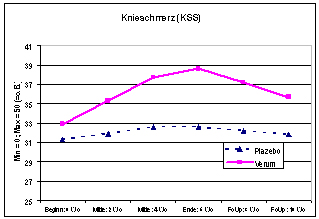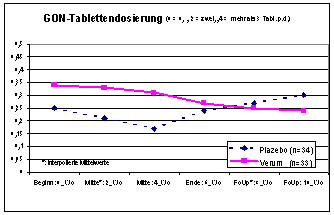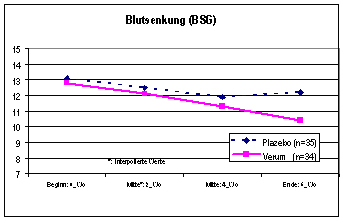|
|
 |
| |
 |
| 05/07/2005 6:51:00 pm |
| Gonarthritis under QRS: Results of a Double-Blind Study in Maribor3 , Nov/Dec. 2000. |
 |
| Introduction and Target
|
 |

|
| Fig.1:) knee pain (KSS): The improvement of the development is significant only for the verum (P < 0,05), for the same initial condit |
Gonarthritis is a degenerative disease of the knee-joint, wide-spread, before all, among adults, emerging mostly from a disproportion between strain and constitution-based performance. Clinical symptoms are rigidity and pain as well as joint instability (after a longer duration). The existing standard therapy is more related to symptoms than to reasons. Mostly a physical therapy is used, the pain is treated by drugs.
Analgesic means, also for this diagnosis the most frequently used therapy, belong to the most frequently bought drugs accumulating to the most expensive drugs in the middle of Europe. Steroids have very often undesirable side-effects, and, even more, the so-called antirheumatic drugs are not only expensive, but also of the utmost problematic nature, because of their partially grave side-effects.
This controlled study checks three important theses:
(1) In the case of gonarthritis, QRS first reduces the pain and subsequently improves the functioning.
(2) The improvement achieved by the QRS will be reduced by a follow-up which is not based on the QRS therapy, but not back to the starting situation.
(3) The laboratory parameters which are related to the ignition process and not situated within the standard area are improved by QRS in the direction of the standard area.
These theses (esp. thesis 1) can be theoretically founded on the improvement of the exchange of ions, based on the experimentally confirmed effects of QRS (see, for instance, Fischer GE, 1996).. There are also empirical results related to the positive effect of magnetic fields doe the clinical picture under investigation.
- Already since the end of the 80es, Turk propagated the adjuvant treatment of diseases of the locomotor system and the skeleton, based on clinically positive results (Turk et al. 1990).
- P. Kokoschinegg (Salzburg) / G. Fischer (Graz) reported 1991 / 92 on a randomized study with 15 Hz - Elf - waves in addition to conventional treatment methods of rheumatic diseases (Kokoschinegg 1996). Some cases of coxodynia and gonarthritis as well as cases of myalgia, cervical syndromes, spondylosis-based neuralgica existed among 78 patients (39 placebo, 39 verum) which could be evaluated. The results (partially weakly significant, P < 0.1) showed a therapeutic advantage of the MF - therapies.
- An empirical report on 16 patients with diseases of the locomotor system and the skeleton (frequencies individually 2 - 24 Hz, field strength 2.52 - 8.82 mT) also included two cases of gonarthritis with a positive therapy (only MF - therapy, not complemented by analgesics; pain reduction on the Dole scale by 9 and 8 points, resp. (= good therapeutic success = improved; see wegner et al. 1995).
-----------------------------------------------------
Dr. Barovic J., Dr. Turk (Maribor, Slovenia); Prof. Dr. Gerald Fischer, Dr. Kobinger (Graz, Austria), Prof. Dr. Rainer B. Pelka (Munich, Germany).
Methods and Patients
Design: Test device and dosage: The test device was a QRS device with patented function (Salut 1) which activates the metabolism (especially the metabolism of cells) by means of ion transportation.
Type of the study and size of the sample: The randomized double-blind study used a test group (placebo) with 36 members and a verum group with 35 members. the test duration was a daily application of 16 minutes over a period of 6 weeks, after that a follow-up of 4 weeks. The test time was 0, 4, 6, 10 weeks after the start (November-December 2000).
Criteria: The efficiency of the QRS therapy has been evaluated by several classical criteria, among others by the knee joint rating using the KSS (Knee Society Score), the pain by several indicators (thesis 1 + 2). The CRP, the P-fibrinogen and the BSG have been taken as ignition parameters (thesis 3).
Realization of the study: 4 participants of the study have been so-called late comers, the initial data of the development, however, is missing only for one patient. 6 participants (4 verum, 2 placebo) broke off, only two of them (1 placebo, 1 verum) before the end of the treatment after 6 weeks. the study has been implemented relatively fast within a period of only 14 weeks and could be finished at January 25, 2001.
Patients: 28 % out of 71 patients were male (all of them from the General Hospital Maribor, all of them with the diagnosis of gonarthritis and frequently at least one more diagnosis); mean value of the age 60 ± 10 years. Approximately 35 % of the patients showed a significant overweight, based on a Broca > 1,2. Both knees have been affected for 83 % of the group, only the right knee was effected for further 14 %, and only the left knee was effected for the remaining 3 %. More than 70 % showed one or more further diagnoses, frequently also from the skeleton " joint " area. More than 50 % have been suffering already more than 5 years. The general state (AZ) of the patients was mostly satisfactory, only for 25 % it was (very) bad.
|
 |
|
 |

|
| |
Results
Compliance and complications: The compliance was surprisingly good (see implementation of the study). The analysis of the total of 49 unexpected events (UEs) supports the expectation that the QRS-therapy has no negative side-effects because all the described cases of acute (joint) pain, vertigo, tiredness, cold/influenza or others occured in all phases in the placebo group two to three times as often as in the verum group. In phase 1 (0 to 4 weeks) 15 UEs occured in the placebo group, only 8 in the verum group. In phase 2 (4 to 6 weeks) 12
UEs occured in the placebo group, only 6 in the verum group. Finally, in phase 3 (6 to 10 weeks = follow-up) 6 UEs occured in the placebo group, only 2 in the verum group.
Efficiency: The KSS knee evaluation improved significantly only for verum (P < 0,01), also in comparison to placebo (P< 0,05)
Pain + perception: The pain perception decreased in both groups, significantly stronger, however, for verum (P < 0,01). Similarly for the general state and the subjective general condition.
The initially (not significantly) higher dosage of tablets of the verum group is finally, during the follow-up, even lower than the dosage in the placebo group.
Laboratory parameters: P-fibrinogen decreases in the verum group, in
opposition to placebo, highly significantly after 6 weeks, this trend is
0,01), also in comparison to placebo (P < 0,05). The same is valid for KSS knee pain. The knee function (P < 0,01) and the walking performance (P < 0,05) also improved significantly, with a short "dent" after 6 weeks. This trend is also valid for C-reactive protein and the blood sedimentation (BSG). The systolic blood pressure also improves significantly after 6 weeks and remains (in opposition to placebo) stable for another 4 weeks without therapy.
Discussion
This study obviously supports the 3 theses. It is only for the functional tests of the knee evaluation (KSS) that the advantage can be seen significantly only in the follow-up. The results indicate that QRS can be used efficiently for the diagnosis "gonarthritis". The efficiency of QRS which was, at the beginning, considered more as an adjuvans, exceeds in many cases the usual, more symptomatic therapy, with simultaneously lower side-effects.
The rather good values in the follow-up indicate stable improvements. However, the results also show that a therapy of 6 weeks surely will not achieve the optimum. Retrospective studies (Pelka 2000, Haas 2001) indicate that a therapy duration of at least 3 months up to 1 year offers an additional advantage. Hence, the study should be repeated with a larger duration (therapy 3 months, follow-up three months), extended by health-economic parameters.
References
Literature:
Fischer G. Magnetfeldtherapie mit ELMAG MK75 mini . Abt. für Medizinische Bioklimatologie am Hygiene- Institut der Universität Graz, A-8010Graz, Universitätsplatz 4 (unveröffentlicht, 1996).
Fischer GE Grundlagen der Quantentherapie. Hecateus Verlag, Vaduz, 1996.
Fuhrmeister ML Bericht über Erfahrungen mit QRS (Siemens Würzburg, 17.06.99, unveröffentlicht)
Gaube W, W Kobinger, Adjuvante MF-Therapie bei ausgewählten Erkrankungen älterer Patienten. Erfahrungsbericht. ÖZPMR, 1999.
Grohmann G, M Krauß et al. Zur Makro- und Mikrozirkulation am Vorfuß + verschiedenen Kompressionsdrücken bei Pat. mit peripheren arteriellen Verschlußkrankheiten. Phlebologie 28, 1999:135-43.
Haas Persönliche Mitteilung auf dem 1.Symposium QRS in Darmstadt, 02.04.2001.
Jacobson J. , W.Yamanashi A physical mechanism in the treatment of neurologic disorders with externally applied pico Tesla magnetic fields. Panminerva Med 37; 1995:98-104.
Kokoschinegg P., G. Fischer Einflüsse gepulster magnetischer Felder niederer Intensität auf biologische Systeme. Graz/Salzburg 1996, Inst. für Biophysik und Strahlenforschung, Jägerbauerweg 22, A-5302 Henndorf/Salzburg (unveröffentlicht).
Krauß M , G Grohmann Messung von peripheren Kreislaufparametern mit NIRP bei Salut1-Therapie. ZÄN, Uelzen, 1997.
Marino AA Moderne Bioelektrizität. West Indies, Trinidad 1997. (Dt.Übers. Magnovit AG, Eschen), 2001.
Orlov L. et al. The influence of running impulse magnetic field on some humoral indexes and physical load tolerability in patients with neurocirculatory hypo- and hypertension. Biophysika, Jg.41, No.4; 1996: 44-48
Pelka RB: QRS-Kunden-Feldstudie 2000. Erfahrungen mit der QRS-Magnetfeldtherapie (Gerät: Salut 1) von 74 Patienten mit verschiedenen Diagnosen, v.a. aus dem Bereich Bewegungsapparat. UniBw München, 09.11.2000 (unveröffentlicht).
Pelka RB: QRS-DSSV-Studie 2001. Randomisierte Doppelblindstudie mit der QRS-Magnetfeldtherapie (Gerät: Salut 2) bei 76 Fitness-Aktiven in Verbindung mit einem Fitness-Training (unveröffentlicht, UniBw München, 18.05.2001).
Turk Z., J Barovic, I Flis Behandlung der ankylosierenden Sondylitis (M.Bechterev) m. Magnetfeldtherapie. Z.Phys.Med.Baln. Med. Klim.19; 1990: 222.
Turk Z. et al. Gepulste Magnetfelder niederer Intensität als adjuvante Therapie bei schwer polytraumatisierten Patienten. Phys. Rehab. Kur Med 2; 1992: 154-156.
Turk Z, J Barovic, G. Fischer, W Kobinger QRS-Therapie bei Gonarthrose-Patienten ? Erste Ergebnisse einer Doppelblindstudie. Allgemeines Krankenhaus Maribor (SLO), 2001 (unveröffentlicht).
Wagner W. , J Barovcic, W Kobinger, G Fischer Erfahrungen mit einem Magnetfeld-Kleingerät bei der Behandlung von Erkrankungen d. Bewegungs- und Stützapparates. Ärztezeitschr. für Naturheilverfahren, 36.Jg.(3); 1995: 192-196.
Paricipants of the study: see authors
|
 |
|
 |

|
| Fig. 3: blood sedimentation The advantage of verum versus placebo will be significant, for the same initial conditions, only after 6 weeks of therapy (P < 0,05). |
|
| |
|
 |
| Published by Prof. Dr. B. Pelka, 05/07/2005 6:51:00 pm (). |
| |
 |
 |
 |
|
 |
 |
 |
| Tip a friend about this article! |
 |
|
|
|
 |
Novato Medic AB | Unnebo 1, S-335 33 Gnosjö, Sweden | Tel:
+46 370-33 36 75, Fax: +46 370-33 36 76
E-mail:
novato@qrs.nu |
|